2016 California Standards for Accessible Design Pocket Guide - Eff. Jan. 1, 2017
11B-703.7 Symbols of accessibility. Symbols of accessibility shall comply with Section 11B-703.7.

11B-703.7.1 Finish and contrast. Symbols of accessibility and their background shall have a non-glare finish. Symbols of accessibility shall contrast with their background with either a light symbol on a dark background or a dark symbol on a light background.
11B-703.7.2 Symbols
11B-703.7.2.1 International Symbol of Accessibility.
The International Symbol of Accessibility shall comply with Figure 11B-703.7.2.1. The symbol shall consist of a white figure on a blue background. The color blue shall approximate FS 15090 in Federal Standard 595C. A border may be provided inside or outside of the minimum required International Symbol of Accessibility dimension.
[2010 ADAS] 703.7.2.1 International Symbol of Accessibility. The International Symbol of Accessibility shall comply with Figure 703.7.2.1.
Exceptions:
1. The appropriate enforcement agency may approve other colors provided the symbol contrast is light on dark or dark on light.
2. On the accessibility function button on hall call consoles in a destination-oriented elevator system the International Symbol of Accessibility shall be a white symbol on a black background.
Figure 11B-703.7.2.1 International Symbol of Accessibility

11B-703.7.2.2 International Symbol of TTY. The International Symbol of TTY shall comply with Figure 11B-703.7.2.2.
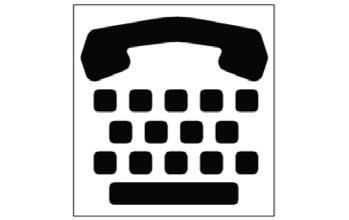
FIGURE 11B-703.7.2.2
INTERNATIONAL SYMBOL OF TTY
11B-703.7.2.3 Volume control telephones. Telephones with a volume control shall be identified by a pictogram of a telephone handset with radiating sound waves on a square field such as shown in Figure 11B-703.7.2.3.
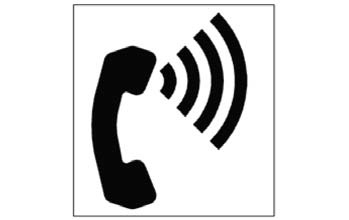
FIGURE 11B-703.7.2.3
VOLUME CONTROL TELEPHONE
11B-703.7.2.4 Assistive listening systems. Assistive listening systems shall be identified by the International Symbol of Access for Hearing Loss complying with Figure 11B-703.7.2.4.
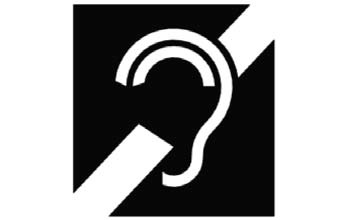
FIGURE 11B-703.7.2.4
INTERNATIONAL SYMBOL OF ACCESS FOR HEARING LOSS
11B-703.7.2.6 Toilet and bathing facilities geometric symbols. Geometric symbols at entrances to toilet and bathing rooms shall be mounted at 58 inches (1473 mm) minimum and 60 inches (1524 mm) maximum above the finish floor or ground surface measured from the centerline of the symbol. Where a door is provided the symbol shall be mounted within 1 inch (25 mm) of the vertical centerline of the door.
When toilet and bathing facilities have doorway openings instead of doors, such as at airports or stadiums, the geometric identification symbol should be located at the proper height adjacent to the opening or incorporated into the required tactile identification sign. For example, the geometric symbol may be used as the sign background with raised characters and Braille per Sections 11B-703.2 and 11B-703.3.◼
11B-703.7.2.6.1 Men’s toilet and bathing facilities.
A triangle symbol shall be located at entrances to men’s toilet and bathing facilities. The triangle symbol shall be an equilateral triangle 1/4 inch (6.4 mm) thick with edges 12 inches (305 mm) long and a vertex pointing upward. The color of the triangle symbol shall contrast with the color of the door or surface on which the triangle symbol is mounted, either light on a dark background or dark on a light background.
Exception: Within secure perimeter of detention and correctional facilities, geometric symbols shall not be required to be ¼ inch (6.4 mm) thick.
11B-703.7.2.6.2 Women’s toilet and bathing facilities.
A circle symbol shall be located at entrances to woman’s toilet and bathing facilities. The circle symbol shall be ¼ inch (6.4 mm) thick and 12 inches (305 mm) in diameter. The color of the circle symbol shall contrast with the color of the door or surface on which the circle symbol is mounted, either light on a dark background or dark on a light background.
Exception: Within secure perimeter of detention and correctional facilities, geometric symbols shall not be required to be ¼ inch (6.4 mm) thick.
11B-703.7.2.6.3 Unisex toilet and bathing facilities.
A combined circle and triangle symbol shall be located at entrances to unisex toilet and bathing facilities. The combined circle and triangle symbol shall consist of a circle symbol 1/4 inch (6.4 mm) thick and 12 inches (305 mm) in diameter with a 1/4 inch (6.4 mm) thick equilateral triangle symbol superimposed on and geometrically inscribed within the 12-inch (305 mm) diameter of the circle symbol. The vertices of the triangle symbol shall be located 1/4 inch (6.4 mm) maximum from the edge of the circle symbol with a vertex pointing upward. The color of the triangle symbol shall contrast with the color of the circle symbol, either light on a dark background or dark on a light background. The color of the circle symbol shall contrast with the color of the door or surface on which the combined circle and triangle symbol is mounted, either light on a dark background or dark on a light background.
Exception: Within secure perimeter of detention and correctional facilities, geometric symbols shall not be required to be ¼ inch (6.4 mm) thick.
11B-703.7.2.6.4 Edges and vertices on geometric symbols. Edges shall be eased or rounded at 1/16 inch (1.59 mm) minimum, or chamfered at 1/8 inch (3.2 mm) maximum. Vertices shall be radiused between 1/8 inch (3.2 mm) minimum and ¼ inch (6.4 mm) maximum.
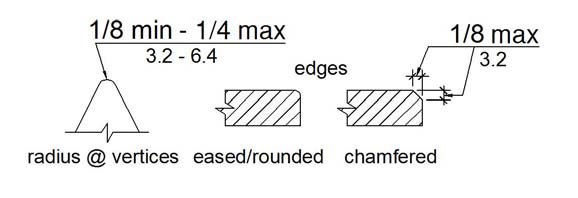
FIGURE 11B-703.7.2.6.4
EDGES AND VERTICES ON GEOMETRIC SYMBOLS
11B-703.7.2.7 Pedestrian traffic-control buttons. Pole-supported pedestrian traffic control buttons shall be identified with color coding consisting of a textured horizontal yellow band 2 inches (51 mm) in width encircling the pole, and a 1-inch-wide (25 mm) dark border band above and below this yellow band. Color coding shall be placed immediately above the control button. Control buttons shall be located no higher than 48 inches (1219 mm) above the ground surface adjacent to the pole.

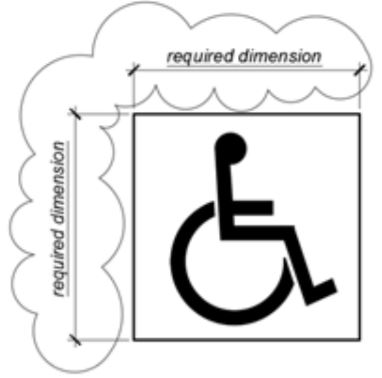

User Comments/Questions
Add Comment/Question